

| Psychidae moths in Nottinghamshire | ||
| ..... | ||
| Though often very small, difficult to find and considerably under-recorded throughout the UK, Psychidae moths make interesting study. Relatively little is known about their range across Nottinghamshire, this page detailing all the county's known species and their current status and making comparisons with the species occurring in the neighbouring counties of Leicestershire and Derbyshire. | ||
| ..... | ||
The Psychidae certainly represent some of the strangest moths found in the UK. They are often known as 'bagworms' which does seem one to be of those annoying American terms which often becomes adopted over here. Of those species which have them, the males are fully winged, but the females of many species are 'grub-like' and wingless, bearing little resmblance to a moth at all. |
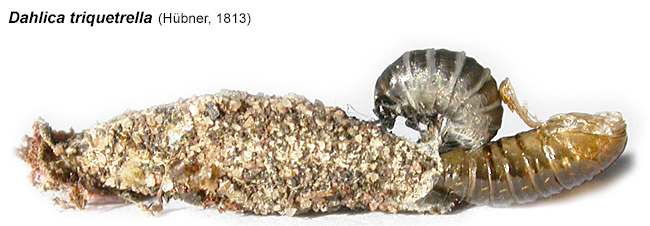 |
|
| ..... | ||
| Some species such as Dahlica triquetrella are
parthenogenetic, meaning that only a self fertile female is known. The
last few years has seen a considerable increase in interest in Psychidae
among UK entomologists and searchingfor the well camoflauged larval
cases during the Winter months, now regularly ills the gap between end
and start of moth trapping seasons. The term 'bagworm' is derived from the case which the larva constructs around itself as it grows. The case is based on a silk tube, to which the larva attaches various items of plant, lichens, algae, sand, insects and debris. Although many Psychidae larvae construct cases that are readily identifiable through combinations of shape, size and material used, this cannot always be guaranteed with 100% certainty between species that constructing similar cases. |
||
| ..... | ||
|
Lepidopterists found that correct identification of the three Dahlicas, can come from the discarded pupal headplate after hatching. Examination under a microscope is then easy to determine species. But the larval case of Dahlica triquetrella is very different to the cases of both Dahlica lichenella and Dahlica inconspicuella and can easily be ruled out before resorting to looking at the pupal headplate. The case of Dahlica triquetrella is longer (though experience of all three cases obviously helps here) at around 8-9mm and there are always insect fragments around the neck of the larval case of Dahlica triquetrella. The pupal headplate of D. lichenella shown on the left, shows the long length of the antennae compared to the rest of the headplate, which is the key to separating Dahlica lichenella from Dahlica inconspicuella. The difference in antennal lengths of the headplate is sometimes not so obvious and they need to be flat to the surface when viewed under the microscope. The antennae of both D. lichenella and D.triquetrella are obviously longer than those of D. inconspicuella. The larvae of many species feed on algae or lichen growing on tree trunks, walls and stones etc. Cases may be found by searching the crevices of Oaks and other trees, but the smooth bark of Beech cases to stand out more easily when searched for. Recent nomenclature changesThere are several UK Psychidae (some featured on this page) currently named differently by European entomologists. When this page was first written well over a decade ago, in order to try and lessen the confusion regarding the nomenclature of many Psychidae, we used European names for all species featured. However, the latest nomenclature appears below. |
|
| ..... | ||
|
In Britain two Luffia species were originally thought to occur. There was Luffia ferchaultella, with self-fertile wingless females and widespread over the southern half of Britain, and there was the bisexual Luffia lapidella, with winged males and wingless females, occurring only in Cornwall, but widespread on the Continent. Larvae and cases of both prospective species are identical and recent DNA tests showed that the two species could not be separated, so they were considered two forms of one species, the bisexual form being Luffia lapidella f. lapidella and the parthenogenetic form (no males) being Luffia lapidella f. ferchaultella. The current thinking here in the UK as of March 2025, is that Luffia ferchaultella is no longer regarded as a seperate species, but as a form of Luffia lapidella and known as Luffia lapidella f. ferchaultella. That means that at the moment, Luffia ferchaultella is now Luffia lapidella. Other name changes currently in use include Diplodoma herminata - now D. laichartingella, Narycia monilifera - now N. duplicella and Bacotia sepium now B. claustrella. A brief history of Psychidae in Nottinghamshire, Leicestershire and Derbyshire The late Ken Cooper's 1993 listing for the county showed just five species recorded from Nottinghamshire. The status of all in Nottinghamshire is presumed by the county recorder as being common and they are without doubt, under-recorded. There still seems little interest in Psychidae among the county's recorders, even though Bankesia conspurcatella was recently added to the county list in rather unusual circumstances. Prior to the onset of our surveying Nottinghamshire Psychidae, there was just one known record of D. laichartingella (at Carlton on August 5th 1988. M. Sterling) showing just how under-recorded these moths have been. Note:- The table below shows the relevant county Psychidae lists as of March 2021. .. * denotes records are considered doubtful by the relevant C/R. |
||
| ..... |
|
||||||||||||||||||||||||||||||||||||||||||||||||||||||||||||||||||||||||||||||||||||||||||||
| Species accounts and photographs | ||
| ..... |
| 11.001 ... B&F 0180 Diplodoma
laichartingella (Goeze, 1783)
|
||
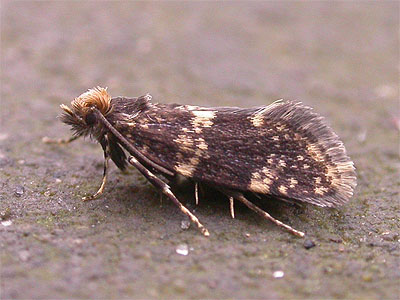 |
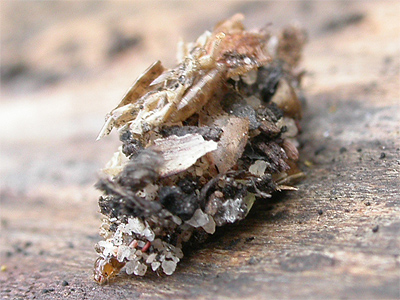 |
|
| ..... | ||
| Mature Diplodoma
laichartingella cases are distinctive, containing a
variety of insect fragments including shed spider and
centipede skins and beetle elytra etc, but particles of
sand and small items of detritus are also included.
Sometimes, cases can be extreme, a good example being
shown above. This species has a two year larval period
and the mature case measures anything up to 11.5mm. During the Winter months, cases can be found tucked well into the characteristic hollows around the roots of mature Beech trees, the larvae becoming active from late March and early April, moving back up the tree trunks to begin feeding. Our observations currently suggest that D.laichartingella is confined to the Sherwood Forest area. Both sexes are fully winged. |
||
| 11.002 ... B&F 0175 Narycia duplicella (Goeze, 1783)
|
||
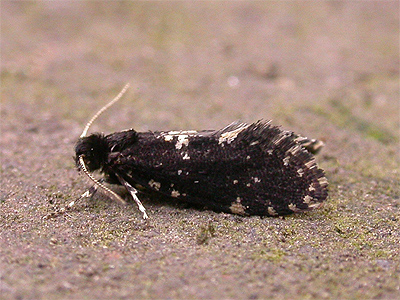 |
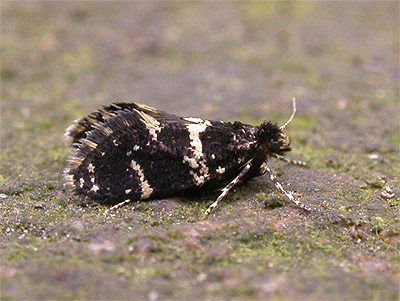 |
|
| ..... | ||
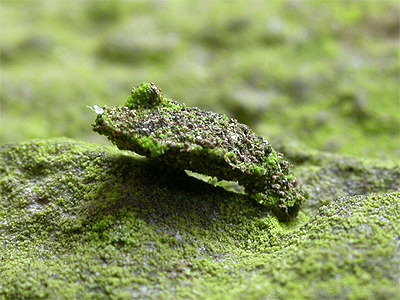 |
 |
|
| ..... | ||
| Measuring around 6mm when full grown, Narycia duplicella larval cases are quite distinctive, being covered in particles of lichen and usually having some form of 'fin like' projection towards the rear upper surface and either side of the case. Larvae become active from late February and early March depending on average daily temperature. Sometimes commonly found near the base of tree trunks, Narycia duplicella has been found to be one of the commonest Psychids in Nottinghamshire, occurring on tree trunks and walls in a variety of situations. Both sexes are fully winged. | ||
| 11.003 ... B&F 0176 Dahlica triquetrella (Hübner, 1813)
|
||
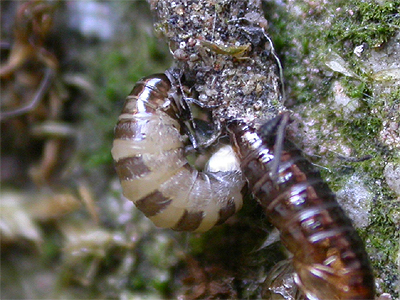 |
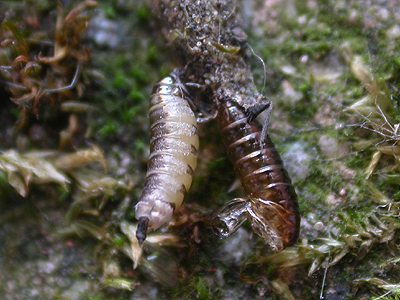 |
|
| ..... | ||
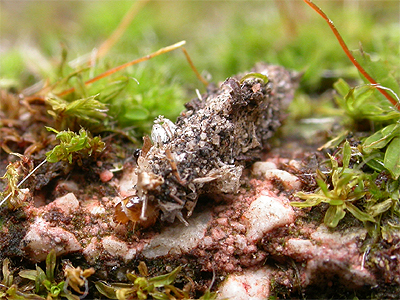 |
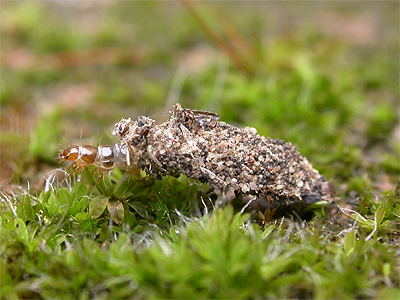 |
|
| ..... | ||
| At one time, this was a generally more uncommon
species in Nottinghamshire, than either Dahlica lichenella
and Dahlica inconspicuella, but in recent years, records have
come from a range of (perhaps unlikely) sites, including a number from
urban locations. There are currently records from the flood wall at Attenborough NR, Newark Railway Station, Hucknall Road, close to Nottingham City Hospital, Retford and Market Warsop Cemeteries, the centre of Mansfield, and both Gunthorpe Bridge and Trent Bridge along the River Trent. Although the larvae of all three Dahlicas produce very similar cases, those of Dahlica triquetrella are slightly larger (close to 10mm) and usually with various insect fragments at the front end and the case is distinctly triangular in cross section. |
||
| 11.004 ... B&F 0177 Dahlica inconspicuella .. Lesser Lichen Case-bearer (Stainton, 1849)
|
||
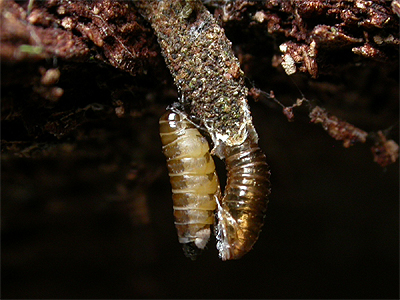 |
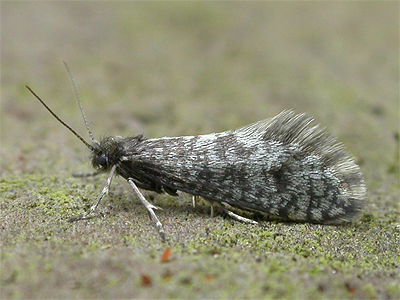 |
|
| ..... | ||
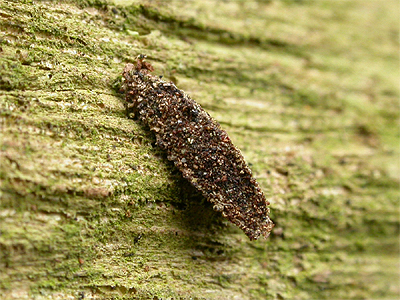 |
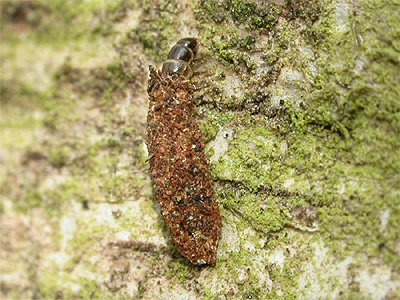 |
|
| ..... | ||
| Fairly common at Sherwood Forest, most especially around the Country Park area, but still a difficult species to find. Larvae are active from late February onwards and can be found ascending the trunks of trees, but will also be found on logs. In our experience, the larval cases of Dahlica inconspicuella (length around 6mm) are less likely to be covered in lichen than Narycia duplicella, but is generally covered in particles of sand and soil etc and look 'fresher' than most other species. Pupation sites are often in the more sheltered locations on tree trunks or on fallen logs or branches. The females of this species are wingless, but the males are attracted to MV light traps operated early in the year. | ||
| 11.005 ... B&F 0179 Dahlica lichenella .. Lichen Case-bearer (Linnaeus, 1761)
|
||
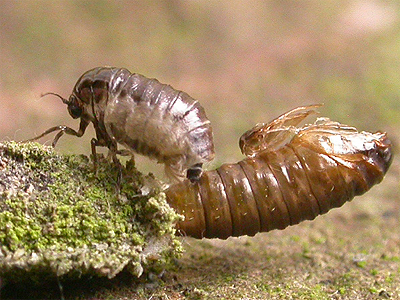 |
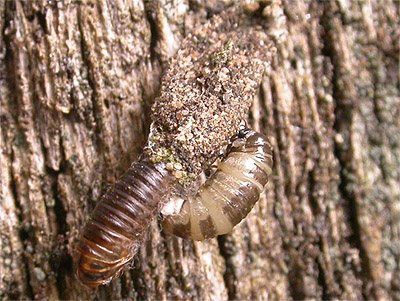 |
|
| ..... | ||
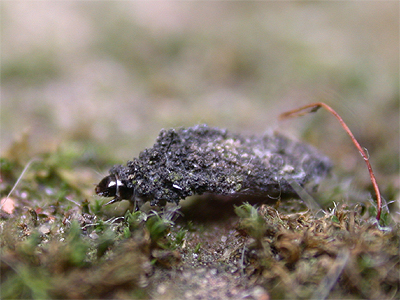 |
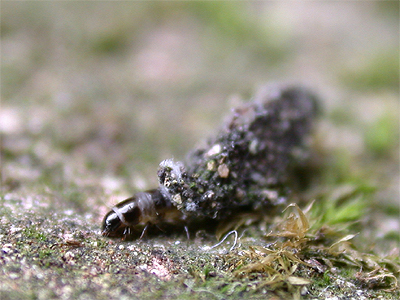 |
|
| ..... | ||
| An uncommon moth, with case lengths between 6-7mm. Larval cases are like Dahlica inconspicuella, being largely covered in particles of sand and soil and seem slightly larger and bulkier. Old cases will be covered in lichens or algae due to age. Numerous cases found on the wall at Market Warsop Cemetery were the first record for Nottinghamshire. The self fertile, flightless females emerge, lay eggs and die within about eight hours. Identification can be confirmed via examination of the pupal head case, which is often still attached to the pupa, sometimes weeks after the female has emerged. | ||
| 11.006 ... B&F 0181 Taleporia tubulosa (Retzius, 1783)
|
||
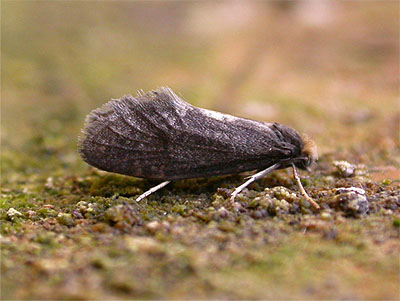 |
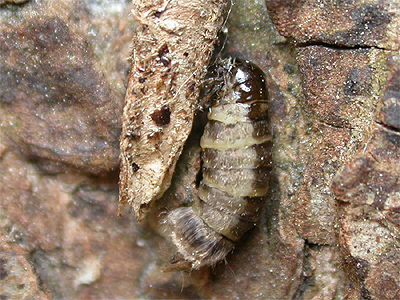 |
|
| ..... | ||
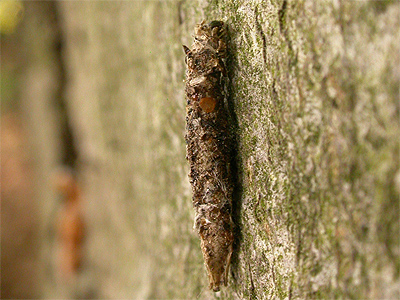 |
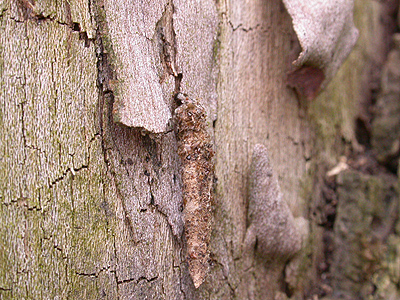 |
|
| ..... | ||
| Empty cases are around 15mm in length, cigar shaped, with some insect fragments around the head end of the case and easy to find on the trunks of trees. Smooth barked trees such as Beech are particularly favoured, especially where there is limited ground-cover. Fence posts are also utilised by the pupating larvae on Budby Common, where the species seems to be quite localised. All cases found during the Winter months are from the previous year. Active larvae remain on the ground until the Spring, then climbing trunks to pupate in suitable sites (second week of May in 2006). T. tubulosa is often abundant where it occurs and only the male is fully winged. | ||
|
11.007
.... B&F 0182
Bankesia conspurcatella
(Zeller, 1850)
|
||
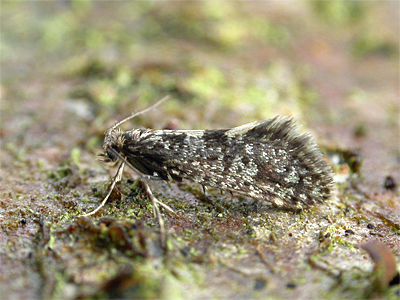 |
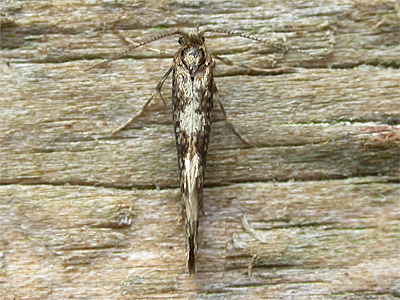 |
|
| ..... | ||
| Only discovered new to Nottinghamshire on February 27th 2021, when found by Phil Cadman on a kitchen wall. The initial identification was thought Dahlica inconspicuella, which is visually almost identical, but in view of the suburban Worksop location and D. inconspicuella's restricted range in the county, it was considered worth checking to be certain of the ID, as Bankesia conspurcatella was strongly suspected. Thanks to the 'gen det' assistance of Martin Gray, the moth was confirmed as being Bankesia conspurcatella. | ||
| 11.009 ... B&F 0184 Luffia lapidella (Stephens, 1850)
|
||
 |
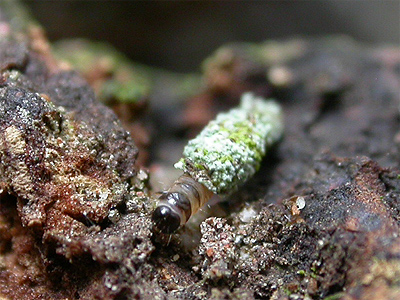 |
|
| ..... | ||
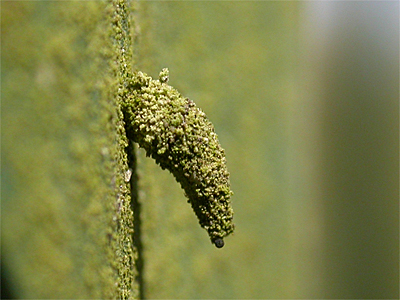 |
 |
|
| ..... | ||
| This is
probably a common species in parts of Nottinghamshire and
more detailed information regarding the present
nomenclature regarding the possible two forms of this
moth was mentioned earlier. At many sites across the
southern half of the UK, the distinctively curved larval
cases this moth, are often found in urban areas than most
other Psychidae. We have so far recorded it on the trunks of trees from Nottingham City Hospital, the Mapperley area of Nottingham, Clipstone near Mansfield (all urbanised areas) before finding it most recently on several trees in the car park of the Sherwood Forest Visitor Centre at Edwinstowe. Where it occurs, it can often be found in numbers, as old cases remain on trees for several years. In early Spring, active larval cases measure just 2.5mm in length and the larvae become active from early March in favourable weather conditions. Older cases (around 6mm in length) are often conspicuously banded with different particles of lichen and algae. |
||
| 11.012 ... B&F 0186 Psyche casta (Pallas, 1767)
|
||
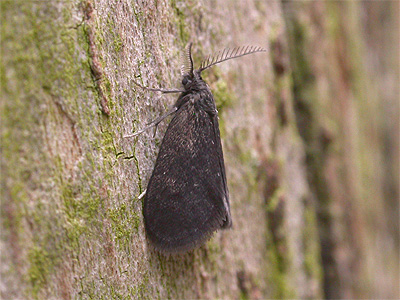 |
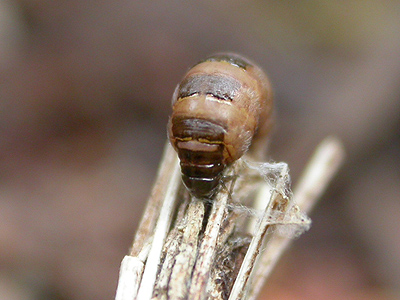 |
|
| ..... | ||
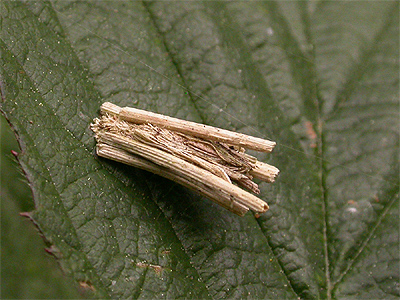 |
 |
|
| ..... | ||
| Psyche casta is one of the easiest cases to find and is common in the Sherwood Forest area. Only the male is fully winged. There are currently only two Eakring records. With a case length of between 8-12mm, it is distinctive enough to be spotted and identified with confidence. Cases can regularly be found on low-growing plants such as Bramble, coarse Grasses and tree trunks during the late Spring and Summer months. | ||
| The status of Nottinghamshire Psychidae - March 2021 | ||
| ..... | ||
| Diplodoma laichartingella is widespread across the Sherwood Forest area, including Duncan Wood, Boughton Brake, Holborn Hill Plantation, Budby South Forest, Bradmer Hill, Gibraltar Plantation and Sherwood Forest CP. There is probably a preference for Beech woodland, unless cases are just easier to locate on Beech trunks, but a number of larval cases were found on metal fencing on an industrial site on Crown Farm Way in Mansfield. Larval cases have proved difficult to find during the Winter months, but searching hollows formed around the roots of Beech trees has proved successful. | ||
| Narycia duplicella has been found at most sites surveyed (including some urban sites) Although the Sherwood Forest area is undoubtedly Narycia duplicella's stronghold, it is without doubt fairly widespread across the county. | ||
| Dahlica triquetrella was recorded for the first time in Nottinghamshire in March 2012, when discovered at Attenborough NR by Richard Rogers. Further occupied cases were later found by Jerry Clough. | ||
| Dahlica inconspicuella was only found at Lound Wood (Eakring) and at Clipstone Old Quarter and Budby South Forest in the Sherwood Forest NNR. It proved quite a difficult species to find, but males have been taken at MV light within the confines of Sherwood Forest CP. | ||
| Dahlica lichenella has proved to have a rather strange Nottinghamshire distribution in recent years Found on trees at Hanger Hill Plantation and on the wall at the entrance to Market Wasop Cemetery, but this population appears to be struggling (March 2020). However it has been found at another Market Warsop site, from Sookholme village and Nottingham City Hospital. In 2019, a larval case was found on fence post at the RSPB's Langford Lowfields NR. A much rarer species than Dahlica inconspicuella, not usually covered with any algae growth and found in late Winter/early Spring. | ||
| Taleporia tubulosa remains one of the most widely recorded species, with the large empty larval cases often remaining on the trunks of trees for two years. There is certainly a degree of favouritism showed towards woodland containing smooth-barked trees such as Beech and Sycamore. It is rare in the Sherwood Forest CP and prefers fence posts to trees where it occurs on Budby South Forest. Huge numbers can occur in May, as larvae descend the Beech trunks at both Holborn Hill Plantation and Hanger Hill Plantation, which are undoubtedly the best sites for this moth in Nottinghamshire. | ||
| Bankesia conspurcatella was recorded new to Nottinghamshire, from a Worksop kitchen in February 2021. A rare moth nationally, this moth should be suspected on catching any Dahlica in urban areas. | ||
| Luffia ferchaultella was recorded on the trunks of mature trees in the grounds of Nottingham City Hospital during July and on roadside Lime trees in the Mapperley area of Nottingham. Large numbers were found in early 2007 on roadside trees at Clipstone near Mansfield. Larval cases found on trees in the Sherwood Forest Visitor Centre car park in early March 2011. Now proving to be much more widespread in the county. | ||
| Psyche casta is widespread and common throughout the Mansfield and Sherwood Forest areas of Nottinghamshire. The larval cases are usually conspicuous and can remain in situ for a number of years. Can occur in almost any habitat and in some unexpected locations, but has not yet been recorded anywhere in Nottinghamshire south past Haywood Oaks | ||
| Thanks
to the following contributors Mark Skevington for the Leicestershire information, Dr Sheila Wright (Nottinghamshire county macro-moth recorder) and Dave Budworth for the Derbyshire records. A special thanks to Henk ten Holt for his invaluable ID help, suggestions/corrections and assistance in writing the Psychidae nomenclature section of this page. |
||